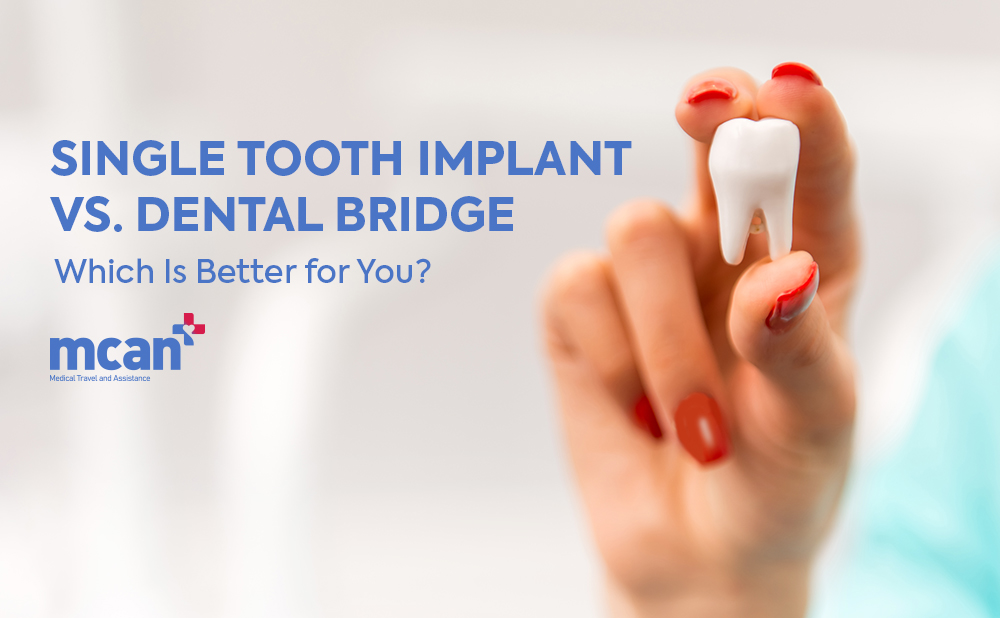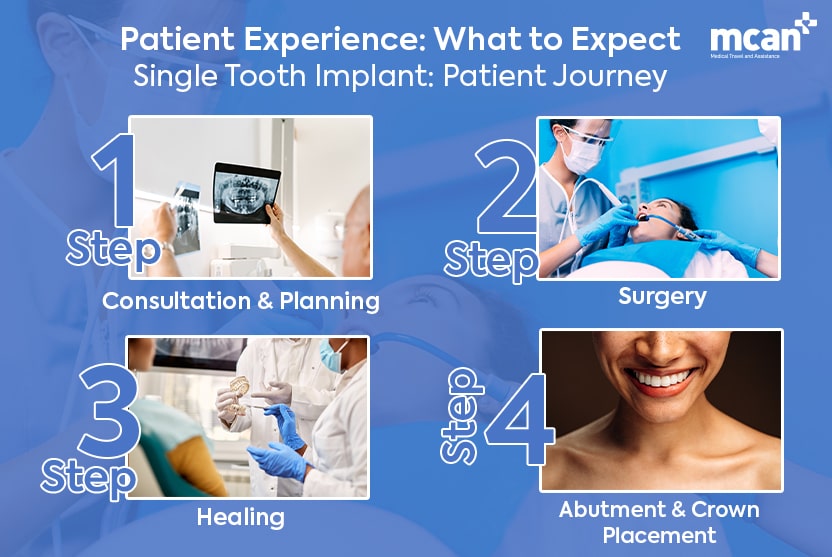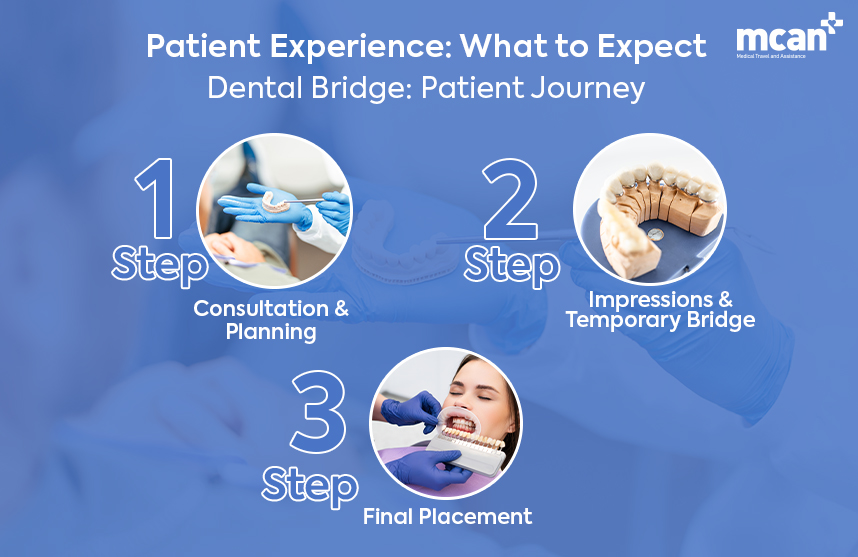
Losing a single tooth can feel like a minor setback, but the way you choose to replace it has long-term consequences for your oral health, confidence, and budget. Two of the most popular solutions, single tooth dental implants and dental bridges, each come with distinct advantages and considerations.
For patients weighing their options, the differences aren’t always obvious at first glance: Should you go for a modern implant that mimics the structure of a natural tooth, or a dental bridge that spans the gap using neighboring teeth for support?
In this guide, we’ll break down what each treatment involves, compare them head-to-head, and highlight the key factors to help you make an informed decision that’s right for your smile and lifestyle.
What Is a Single Tooth Implant?
A single tooth dental implant is considered the gold standard for replacing one missing tooth. This treatment involves surgically placing a small titanium post into the jawbone where your tooth is missing. Over a few months, the implant fuses with the bone, a process called osseointegration, creating a sturdy, artificial root.
Once healed, an abutment is attached to the implant, and a custom-made crown is secured on top. The result is a new tooth that looks, feels, and functions almost exactly like a natural tooth. Importantly, this method does not rely on support from neighboring teeth, which helps preserve your overall dental health and jawbone integrity.
Key Benefits of Single Tooth Implant:
- Restores full chewing power and natural appearance
- Helps maintain bone structure by preventing bone loss in the jaw
- Does not affect or compromise healthy adjacent teeth
- Designed for long-term durability
What Is a Dental Bridge?
A dental bridge is a tried-and-true method for replacing one (or sometimes two) missing teeth by literally “bridging” the gap between healthy teeth. The most common type, a traditional bridge, uses the natural teeth on either side of the gap as anchors (abutments). These supporting teeth are typically filed down and fitted with crowns, and an artificial tooth (pontic) is suspended between them.
Key Benefits:
- Provides a natural look and feel for restored confidence
- Fast turnaround, usually completed within 1–2 weeks
- Restores chewing and speaking function immediately
- A proven, non-surgical solution for those not suitable for implants
Head-to-Head Comparison: Single Tooth Implant vs. Dental Bridge
When it comes to replacing a missing tooth, both implants and bridges have distinct advantages and trade-offs. The table below highlights the most important differences in real-world terms:
| Factor | Single Tooth Implant | Dental Bridge |
|---|---|---|
| Appearance & Feel | Most natural look and feel, preserves gumline | Good esthetics, but may change with gum over time |
| Durability/Longevity | 15+ years to lifetime with good care | 7–15 years on average, may need replacement |
| Impact on Neighboring Teeth | No effect, leaves healthy teeth untouched | Requires grinding of adjacent teeth for support |
| Bone Preservation | Yes, prevents bone loss at the site | No, bone may shrink under the missing tooth |
| Procedure Time/Recovery | Longer (months; includes healing after implant surgery) | Shorter (usually 1–2 weeks; no surgery required) |
| Maintenance | Clean like a natural tooth, easy hygiene | Special cleaning tools needed under the bridge |
| Cost (Initial & Long-Term) | Higher initial, lower over time (due to longevity) | Lower initial, may cost more long term (replacements needed) |
Who Is a Good Candidate for Each Option?
Choosing between a single tooth implant and a dental bridge isn’t just about personal preference: Your dental anatomy, medical history, and treatment goals all play a role. Here’s what to consider:

Ideal Candidates for a Single Tooth Implant
- Healthy Jawbone: You need sufficient bone volume and density to anchor the implant securely. If bone has receded, grafting may be required.
- Good Oral and General Health: Implants succeed best in patients with healthy gums, no active gum disease, and stable health overall. Conditions like uncontrolled diabetes or smoking can affect healing.
- One Missing Tooth or Gaps Not Suited for a Bridge: Especially recommended if the neighboring teeth are healthy and shouldn’t be altered.
- Long-Term Solution Seekers: Ideal for patients who want a durable, natural-feeling result and are willing to invest time in treatment and healing.
Ideal Candidates for a Dental Bridge
- Insufficient Bone for Implant: If bone loss is significant and grafting isn’t an option or preferred, a bridge may be the better choice.
- Medical or Financial Considerations: Patients unable to undergo surgery or looking for a more affordable, quicker solution may benefit from a bridge.
- Multiple Adjacent Missing Teeth: Traditional bridges can span more than one missing tooth, using healthy neighboring teeth as anchors.
- Healthy Adjacent Teeth (But Not Pristine): If adjacent teeth already have large fillings or crowns, preparing them for a bridge won’t sacrifice healthy tooth structure.
Key Considerations
- Age Is Not a Barrier: Both treatments can be successful in adults of any age, provided health criteria are met.
- Personal Preferences: Some patients prefer to avoid surgery, while others prioritize bone preservation and long-term value.
To help you make a truly informed decision be sure to check out our article Choosing the Best Dental Clinic in Turkey, which highlights what sets top clinics apart and what international patients should consider before booking.
Pros & Cons: Key Takeaways
Choosing between a single tooth implant and a dental bridge involves weighing distinct advantages and drawbacks. The table below summarizes what you need to know:
| Key Takeaways | Single Tooth Implant | Dental Bridge |
|---|---|---|
| Pros | – Preserves jawbone- No impact on neighboring teeth- Highly durable (10–20+ years)- Natural look & feel- Easy to clean (like your own tooth) | – No surgery required- Faster treatment & healing- Lower initial cost- Effective if adjacent teeth need crowns anyway- Suitable for patients with less bone volume |
| Cons | – Surgical procedure required- Higher upfront investment- Longer timeline (healing needed)- Not ideal with severe bone loss (without graft) | – Requires grinding down adjacent teeth- Does not prevent bone loss in gap- May need replacement every 5–10 years- More challenging to clean under pontic- Can compromise support teeth over time |
Patient Experience: What to Expect
When deciding between a single tooth implant and a dental bridge, understanding what the journey actually feels like can help you set realistic expectations.
Single Tooth Implant: Patient Journey

Procedure & Recovery:
- Step 1 – Consultation & Planning: Digital scans and X-rays are taken to assess bone and oral health.
- Step 2 – Surgery: The implant post is placed into the jawbone under local anesthesia or sedation.
- Step 3 – Healing: Osseointegration (bone fusing to implant) takes 2–4 months. A temporary tooth may be provided.
- Step 4 – Abutment & Crown Placement: Once healed, the abutment and final crown are attached.
Pain & Healing:
Most patients describe mild to moderate post-surgery discomfort, managed with medication and ice packs. Swelling typically subsides within a few days. Regular check-ups ensure smooth healing.
Adjustment Period:
Chewing and speaking feel almost natural with the final crown. Cleaning is straightforward; just brush and floss as you would a normal tooth.
Dental Bridge: Patient Journey

Procedure & Recovery:
- Step 1 – Consultation & Preparation: Teeth adjacent to the gap are reshaped to support the bridge.
- Step 2 – Impressions & Temporary Bridge: Dental impressions are taken and a temporary bridge is placed while the permanent one is crafted.
- Step 3 – Final Placement: The custom bridge is cemented in place, restoring function and appearance.
Pain & Healing:
There’s usually minimal discomfort, mostly from reshaping the adjacent teeth. Most patients resume normal activities the next day.
Adjustment Period:
A bridge feels comfortable after a brief adaptation period, but you’ll need to learn to clean under the “pontic” (false tooth) using floss threaders or interdental brushes.
Life After Placement: Daily Function & Maintenance
- Implant: Feels and functions like a real tooth; no food restrictions. Brush and floss normally, and visit your dentist regularly for check-ups.
- Bridge: Restores chewing and aesthetics, but extra care is needed to clean under the bridge. Avoid very hard foods that could damage the restoration.
Why Choose MCAN Dental for Tooth Replacement in Turkey?
Choosing the right clinic is as important as choosing the right treatment. At MCAN Dental, our focus goes beyond replacing a single tooth. We’re committed to giving every patient a comfortable, predictable, and confidence-boosting dental experience in Istanbul.
Why international patients choose MCAN Dental for implants and bridges:
- Expertise You Can Rely On: Our implantologists and restorative dentists have extensive experience with both single tooth implants and modern dental bridges. Every case is approached with precision, from digital smile design to advanced surgical techniques.
- Personalized, Honest Advice: We know that every patient is unique. You’ll receive a transparent assessment of which solution suits your anatomy, oral health, and personal preferences.
- Cutting-Edge Technology: MCAN Dental invests in the latest diagnostic and treatment tools, including CBCT scanning, 3D implant planning, and digital impressions. This technology translates to safer procedures and better, longer-lasting results.
- Multilingual, Dedicated Support: Traveling to Turkey for dental care is made easy with our multilingual team and personalized patient coordinators. From airport pickup and hotel arrangements to aftercare, we support you every step of the way.
- All-Inclusive Packages & Aftercare: Our transparent packages include treatment, accommodation, transfers, and all necessary follow-up. Plus, our 12-month remote aftercare system means you’re never on your own, even after you’ve returned home.
If you’re deciding between a single tooth implant and a bridge, MCAN Dental provides the clinical skill, honest advice, and patient-focused care that makes the journey as smooth as the results.
